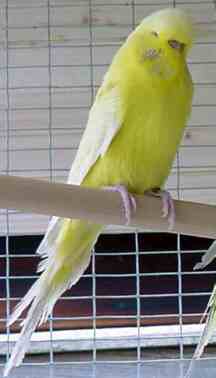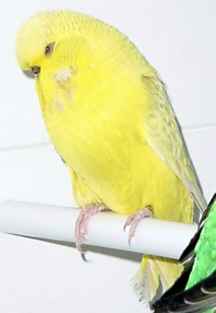
Breeding with
Lacewings
by Roy Powell
Photos: Phil Hodgkin of two Lacewings purchased from Dave Gilman

|
Breeding with
Lacewings
|
|
Often fanciers ask the question of how to make a start with Lacewings. My answer is the same as starting in any other variety. You must like the variety visually, you need to read about it, discuss and understand the genetics and breeding characteristics of the variety. (Remember you are probably committing yourself to a 5-7 year programme before you have established a winning line). You need to visit shows and look at the variety, making notes of breeders' names. It may be that the birds you are looking at did not win the class, this could have been because they were against other varieties in the AOC class which sometimes gives the Lacewing an uneven chance. Probably, the Specialist and Rares shows will give the best indication of the variety and of the quality which is around now.
The Lacewing is a sex-linked variety, so it is no use starting with hens as you waste a year trying to breed splits. You could start with a single cock as I did, but again it is a long process. My suggested initial purchase would be two cocks and four hens. If more can be afforded, then so much the better because it can take some time to accumulate Lacewings in quantity, especially cock birds. It is important that you decide whether you want White (Blue Series) which in my opinion are more difficult, or Yellow (Green Series) Lacewings. It is not advisable to try and mix the twp colours.
The most important feature of the Lacewing is the Cinnamon marking which is best observed in the normal variety. Although you will find it easier to purchase larger Opalines, the wing markings will be more faint. Blue or green sheen is another consideration when selecting your initial stock; this is similar to that on Inos, however, this can be eradicated during the second or third year of breeding. If you can buy birds with size and style, so much the better. However, you will probably find that you willl need to work on any stock available for sale.
Whilst it is best to buy from a winning stud, in the case of Lacewings, the number of specialist breeders is more restricted, and it is usually a case of buying from whatever source is available. Alternatively, speak to a known breeder early in the season and ask him to let you know when he will have stock available.
Initially, I would not suggest outcrossing until you have a quantity of related birds. Probably the first outcross would be in the third year. This outcross would only be used once in a family and in the following two years I would pair Lacewing to Lacewing again to revitalise the colour. The aim of the outcross would be to produce split cocks and visual hens, outcrosses generally are Cinnamon Dark Green or Cinnamon Grey Green for the green series, and Cinnamon Grey for the blue series. Other breeders use Normals instead of Cinnamons, whatever works for you is the answer.
Purity of the Lacewing relates to colour and markings. Colour is best achieved by pairing like to like. However, this tends to lead to a loss of size and shortening of the mask eventually. Fertility is also affected if you continuously pair related families together. Unfortunately, the Lacewing takes eighteen months to reach maturity and during that period should be allowed to fly in flights, but not studied for quality. Year old birds can be used for breeding, but I find they breed better in the second year, they also develop during this breeding period.
I would not use birds related closer than half-brother to half-sister, as when I have tried closer than this, I did not succeed. I also feel that fertility must be watched when breeding this close, I generally go no closer than cousins.
In the Lacewing, the most important feature other than the "Budgie" are the markings. These are also the most difficult to maintain, especially in the Opalines. I do not advocate the pairing together of two birds with faint markings as this will exaggerate the problem.
When deciding on outcrosses, the same rule applies as does to Inos. Don't use Light Green to the Yellows and stay away from Skyblues with the Whites.
I attribute the success I have had with Lacewings to three things: